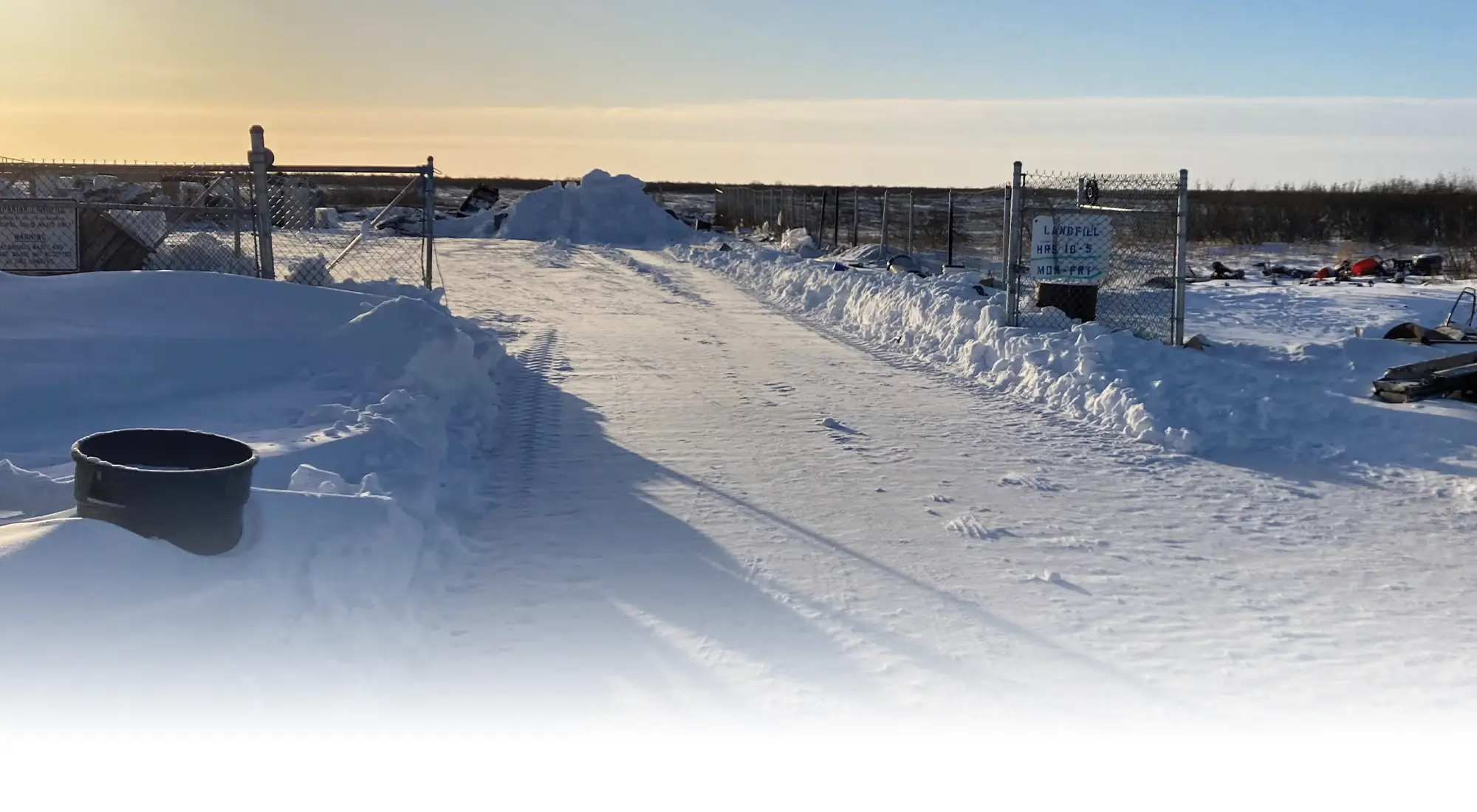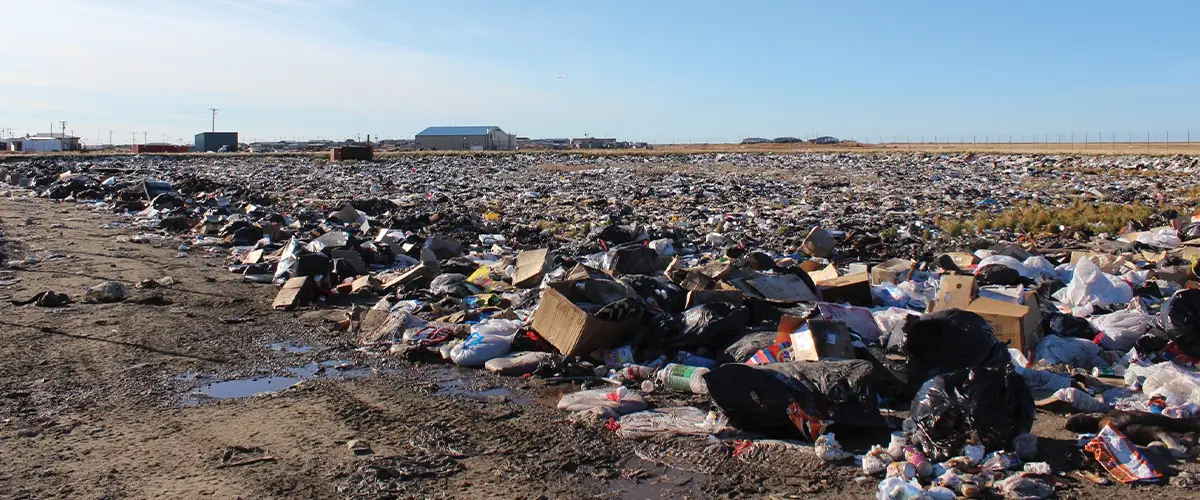
Trash Is Cash
The vital support of waste hauling services
Alaska Department of Commerce, Community, and Economic Development | Division of Community & Regional Affairs
azardous materials removal jobs are booming. The Alaska Department of Labor and Workforce Development forecasts only one other occupation will increase more by 2032, namely “Extraction Workers” in the mining and oil and gas industries.
Both occupations go hand in hand, according to John Scoresby, territory sales executive for Republic Services in Anchorage. “Anytime you open a new mine, there’s a lot more demand for environmental work,” he observes, noting the parallel growth with North Slope activity too.
The occupational forecast backs up Scoresby’s guess. The next three highest-growth jobs by 2032 are welders, geologic technicians, and underground mining machine operators.
Increased investment in the extraction industries is also driving a surge in construction—and there, too, waste removal is an allied trade. Every construction site has a bin for collecting debris, and hauling it away is somebody’s job.
“We can ship it all the way from Eielson to our Grandview landfill via rail, which is much lower cost than over-the-road trucking,” Scoresby explains. That’s Grandview, Idaho—so the containers run from the end of the Alaska Railroad tracks, up and around Fairbanks, and down to the Don Young Port of Alaska to be shipped to another rail terminal in the Lower 48.
“We have the full turnkey service,” says Scoresby. “We provide the container that we own; we’ll load the container; we’ll manage the logistics from A to B; and we’ll dispose of it. All in house.”
Why the voyage to spud country? “There is no hazardous waste landfill in Alaska. All of it must leave, regardless of who you are or who’s shipping it,” Scoresby says.
More specifically, all the landfills in Alaska are designated by the US Environmental Protection Agency (EPA) as “Subtitle D” facilities under the Resource Conservation and Recovery Act, the 1976 federal law governing solid waste disposal. Subtitle C facilities can accept hazardous waste, but Subtitle D landfills can’t.
Military waste, like the loads from Eielson, is not necessarily hazardous, but Scoresby says municipal landfills typically reject it. “They can accept or deny whatever they want. Their main stakeholders are residents of the borough or the city,” he says. “They’re quite picky about what they want to accept or not accept.”
Republic Services is fortunate, then, to own its own landfills like the one in Idaho. Scoresby says, “That’s unique to us, to be vertically integrated that way. Our employees in Fairbanks can load that rail car, and we oversee transportation all the way through.”
Alaska Waste runs the largest fleet of garbage trucks in the state. When businesses, schools, or homes have dumpsters outside, Alaska Waste is most often picking them up. From Ketchikan to Nome to Unalaska and every major community in between, the company offers residential, commercial, and construction services. The latter type of customer would be contracting a hook-lift container or the larger roll-off container, 22 feet long and 8 feet wide. They come in varying heights, with the tallest holding 40 cubic feet.
By contrast, Republic Services specializes in 20-foot open-top containers. “If you have a very large quantity of solid waste that needs out-of-state disposal, typically the most cost-effective solution is loading it into 20-foot open-top containers,” Scoresby says. “They could be filled with anything from petroleum-contaminated soil to metal-bearing hazardous waste. Any sort of solid waste could go into those roll-off containers.” With a fleet of forty containers kept in the state, Republic Services can equip job sites that might need dozens, without having to ship more boxes from the Lower 48.
Handy as they are, they’re not as common as the 22-foot skips or commercial dumpsters in the Alaska Waste fleet. Scoresby notes, “It’s kind of unique. There’s only a handful of folks that are transporting hazardous waste in those 20-foot open-top containers.”
That said, waste hauling customers come in all sizes. Scoresby says, “It could be a home that has a diesel spill in his backyard from his heating oil tank, or it could be ConocoPhillips or any of these big oil companies on the North Slope that need hazardous waste disposal.”
Doug Huntman, owner of Delta Backhaul Company, says his company helped remove approximately 3.2 million pounds of material for recycling and offsite disposal in 2023. He calls the challenge of waste management in rural Alaska “significant.” The costs associated with importing goods are already high, and shipping waste out is next to impossible with small budgets, and the system for shipping in goods not designed to go the other way.
In many cases, budgets may not allow for the complete removal of all waste in a single season, so as a practical option, Huntman plans for phased removal. “Several of our larger backhaul projects span over two or three years. Focusing on ‘low-hanging fruit’ initially allows communities to plan for subsequent collections as time and funding permit,” he says.
The short summer season—only 151 days—requires careful planning. Communities have numerous priorities, such as subsistence hunting, city or tribal projects, and recreation. Hiring a dedicated crew can expedite waste management projects. Huntman says, “The barge schedule is crucial; if you miss it, waste will be stuck until the next season.” Smaller regional barges often have more flexible schedules, which can be advantageous for backhaul projects, although extreme weather can complicate matters.
Aviation is another option for more valuable waste streams, such as recyclable materials. Alaskans for Litter Prevention and Recycling (ALPAR) has coordinated the Flying Cans program to reclaim aluminum from rural Alaska communities that are off the road system. Laurel Andrews, community outreach coordinator at Alaska Waste, says communities might be interested in contacting ALPAR. Depending on the community, ALPAR might have applicable programs or insights that could be beneficial.

The Backhaul Alaska program visited the unlined dump in the Western Alaska village of Hooper Bay last August and inventoried three 20-foot containers of electronics waste, one container of household hazardous waste, one of lead acid batteries, and one of fluorescent light bulbs.
Alaska Department of Commerce, Community, and Economic Development | Division of Community & Regional Affairs
Kilger says asbestos and other hazardous materials are still prevalent in older construction. Furthermore, “the larger landfills in the state have EPA regulations they must comply with [when it comes to] the handling of all materials.”
Hazardous materials and environmental services are Scoresby’s bailiwick. Republic Services added the business line to its core concern of curbside pickup and residential dumpster rental; it’s one of the largest trash pickup providers in the country, next to Waste Management, Inc.
“You can only grow the garbage business so far,” Scoresby says, “so they branched into the environmental solutions space, specifically with hazardous waste.”
Regulations aimed at hazardous waste are enforced in the state by DEC. Rules cover common household items that, at the end of their useful lives, become hazards to the environment unless handled properly.
These include pesticides; some aerosol cans; mercury-containing devices like thermostats and switches; electric lamps with fluorescent, sodium vapor, mercury vapor, or high-intensity discharge bulbs; and batteries containing lithium, nickel-cadmium, mercury, silver-oxide, and lead-acid. Some other types of batteries—such as alkaline and carbon zinc cells, in which mercury wasn’t included in the manufacturing process—might not be classified as hazardous waste and, consequently, wouldn’t fall under the rule. That said, with an eye on responsible practice, rather than being sent to a landfill, those batteries should be gathered and transported to recycling facilities.
With lithium-ion batteries increasingly entering the waste stream, abiding by strict protocols for safe packaging is paramount, Huntman points out. “If not handled properly, these batteries can pose significant fire hazards, so proper training for your crew on identifying and packaging such materials is critical,” he says.
For that reason, Republic Services operates a thermal desorption facility at Moose Creek, not far from the front gate of Eielson Air Force Base. Heating up contaminated soil releases petroleum or perfluoroalkyl and polyfluoroalkyl substances, which are disposed of separately in an afterburner unit while the clean dirt is hauled away.
For liquid waste, Republic Services has a water treatment facility in Anchorage. “No Subtitle D landfill can take liquids,” Scoresby says. “If you spill some diesel in the local pond, you can’t take that water to the municipal landfill. But you have to take it somewhere; it’s contaminated. That’s a service we provide.”
Local processing is generally a preferred option, according to Huntman. For example, clean used oil can be burned in used-oil furnaces for energy recovery. Although the initial investment may seem high, it often pays for itself within a few seasons. Municipal solid waste, like household garbage, can be buried or burned for volume reduction, but it’s crucial to research state laws and local ordinances regarding burning regulations.
In the United States, construction and demolition waste makes up 25 percent to 40 percent of the waste disposed of in the country, according to DEC. Fortunately, it’s handled fairly easily at municipal landfills or at private facilities, such as the C&D Waste Monofill in Palmer operated by Alaska Demolition.
Waste hauling and disposal is an essential part of completing construction jobs in Alaska, putting away what’s torn down even as something new is built up.
“Most folks who live in Alaska enjoy the beauty of the outdoors, and we help maintain that,” Scoresby says. “Every project we have is taking contaminated waste of some kind and making sure it ends up in the right place, not contaminating the environment somewhere. I would say that’s something to be proud of.”